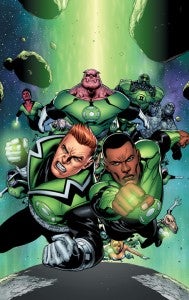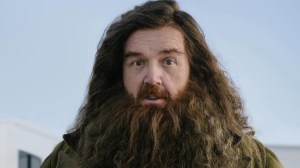With only another day left before the final week of DC’s New 52 rolls out its titles, it’s time to look back at the last batch of last week’s releases and take stock in what we had. Here, of course, is where I get to roll my eyes a bit at Starfire’s sex scene.Green Lantern Corps #1 – ***1/2Written by Peter J. Tomasi; art by Fernando Parasin and Scott HannaIn spite of a rather gratuitous bit of violence in the opening pages, and the unfortunate title The Triumph of the Will, an unmistakable reference to a well-known Nazi propaganda film, this is not a bad comic.Driven by the strength of the Green Lantern property at present and the never-ending drumbeat of Geoff Johns’s ever-deepening GL mythology, the story seems likely to tie into this week’s Green Lantern: New Guardians, as much of it takes place on the fringes of sector 3599, near the site of the slaughter of Atrocitus’s people in sector 3600.That said, the space-opera aspect of the book really doesn’t grab me in this first issue as much as the quieter, smarter moments. Guy Gardner and John Stewart are each ably introduced to new readers, with each struggling with the same major problem that Hal Jordan did: It’s hard to live your life as a regular human being when you’re always off in space playing Green Lantern. The leads in this title, of course, have the added wrinkle of their identities being public, which neither seem to be all that happy about at present.Both characters are returned to their roots a bit, with John fighting his client (he’s an architect, remember?) over safety standards and coming out on the side of social justice as opposed to continued employability. Guy, meanwhile, is looking for a job coaching at a school. Those who have been reading long enough to remember when Guy had a backstory will recall that he has worked in special education, and also was a college football standout, playing on the same team as John Henry Irons, a scholarship student who would later make his old mark on the old DC Universe. Of course, the question posed for Guy is an interesting one: Even if he can keep the kids on his team safe from aliens and villains of all kinds, what’s the sense in having a teacher who you know going in may have to leave at any moment? It might be illegal to discriminate against American soldiers, but the Green Lantern Corps enjoys no such Constitutional protection.This is the best book so far in fulfilling DC’s early promise that the books would be more character-driven and that things like secret identities and supporting casts won’t be forgotten. Unfortunately, it’s somewhat hobbled by the very thing that will bring in most readers: A shallow and uninteresting space-opera A-plot.Legion of Super-Heroes #1- ***Written by Paul Levitz; art by Francis Portela and Javier MenaThe nice thing about coming to the Legion of Super-Heroes after a relaunch is that new readers and old readers are usually just about equally confused.Levitz does an able job of making sure each character gets some “screen time” and that new characters are introduced or explained for older readers. Still, the sense that you’re jumping onto a moving train, then missing your handhold and getting dragged along backwards on your ass, is pretty palpable here. It’s a feeling that I’ve had almost every time I’ve tried to read a Legion story.Certainly there’s something to the criticism that the Legion operate outside of the “regular” DC Universe and so lack a sense of cohesion and mutual consequence that’s present in other titles—and the relative ease with which I jumped onto Fabian Nicieza’s entertaining Legion Lost seems to bolster that argument—but I think that with a book like Demon Knights out there, knocking the socks off of people from all the way back in the days of Camelot, that’s a hard argument to swallow.Longtime fans will likely be pleased at the idea that the rest of the DCU has finally been affected by a Crisis that doesn’t seem to have had much of an impact on the Legion of Super-Heroes, but ultimately the history they’ve retained is a liability to new readers, and neither the plot nor the writing (both capably handled but not incredible) help to take the comic to the next level.Nightwing #1 – ****1/2Written by Kyle Higgins; art by Eddy Barrows and J.P. MayerAfter talking to Kyle Higgins about Nightwing and Deathstroke earlier this month, my enthusiasm for this title was piqued. Higgins has an original and interesting take on the character that doesn’t negate the existing mythology (which, because of the nature of Gotham City, is still largely intact despite the relaunch of the publishing line), and Barrows brings something to the art that feels like Jim Aparo with a modern twist.This is a very good comic.As Higgins warned in our previous interview, there’s quite a lot of talking and quite a lot of exposition in this issue but it doesn’t slow things down. Even with all those narration boxes, the book still moves along at a steady clip, setting up not only the character’s new status quo but also the foundation for the first story arc with Dick’s return to Haly’s Circus.(Apparently the E in “Haley’s” was lost as part of the relaunch. Don’t let them tell you that Batman and Green Lantern are immune!)At any rate, this is the kind of book that doesn’t completely take the top of your head off but which, when you stop and think back on it, you say “Hmm…there really was just nothing to complain about in that comic!”Y’know—except maybe the whole Batman & Robin costume thing.Red Hood and the Outlaws #1 – **Written by Scott Lobdell; art by Kenneth Rocafort and BlondWhile Nightwing features Dick Grayson, the first Robin and the one who has most successfully created a post-Robin identity for himself, Red Hood and the Outlaws stars Jason Todd. Jason was, of course, Dick’s successor and remained dead for quite some time after A Death in the Family, only to be resurrected a few years ago by Catwoman writer Judd Winick.In spite of a bunch of controversy surrounding that on the part of readers, the character has become a profitable one for DC, including the release of Batman: Under the Red Hood on home video.So joined with former Green Arrow sidekick Arsenal and the alien princess Starfire (who, apparently, did used to work wih Dick Grayson and Arsenal, at least for a while), he has his own little team going. Their agenda is as-yet unclear, with this issue featuring Red Hood breaking Arsenal out of jail and then the merry trio heading off to an undisclosed location for sex.There’s also an agenda being set by Essence, a mysterious woman who only Jason can see, and a guy at a computer (reporter? Conspiracy nut? Pornographer?) who’s very excited to see Internet video of Starfire. Neither seems too relevant at the moment,except that Essence sends Jason on what appears to be a suicide mission while Starfire and Arsenal are making whoopie.As much as the preposterous, cheesecake take on Starfire and the “I’ll sleep with anybody” way that her personality comes across have been attacked, the one really interesting concept introduced by this book is the idea that humans are interchangeable to her, and that she sometimes even has trouble just differentiating them. Remembering that aliens are a whole other species—even the hot ones—and that you couldn’t pick that possum in your back yard out of a possum lineup, it’s a logical and interesting take on inter-species relations that begs the question: What if she takes aim at the wrong one?But that, and some beautiful color work by Blond, isn’t enough to bring me back after a disappointing and frankly pretty dumb first issue.Supergirl #1 – ****1/2Written by Michael Green and Michael F. Johnson; art by Mahmud Asar and Dan GreenI have never particularly liked Supergirl.Well, that’s not completely true. On Peter David’s cult-favorite run, I always enjoyed the adventures of Matrix and the various different weird forms that title took.But I saw the old-school takes on Supergirl and Superboy as pretty redundant to Superman, and lacking a supporting cast or strong personality of their own they just became token “girl” and “boy” versions of Kal-El. As the post-Crisis versions of those characters that I loved faded into memory or became impossible to differentiate from their predecessors, I lost interest in them.The New 52 has completely revitalized both in unexpected and exciting ways; Supergirl was one of the week’s—indeed, the month’s—best books and sets up a fascinating sci-fi take on the character that much better fits the promised “fish out of water” feel than I expect we’ll get with the Superman titles.The first issue starts with her crash to earth and is a frantic, action-packed ride for the reader and an unrelenting horror show for the unsuspecting heroine, who apparently wasn’t briefed before she left Krypton. Her voice is strong and unique, and it builds to a conclusion that makes you want to turn the page and read #2.This is exactly what I want from a Supergirl comic, and I didn’t even know it.Wonder Woman #1 – ****Written by Brian Azzarello; art by Cliff ChiangOver the years, many writers have tried to infuse Greek mythology into Wonder Woman’s stories, with varying degrees of success. Brian Azzarello has certainly nailed it here.That’s a bit of a backhanded compliment, in a way–the thing that stops this book from achieving the fantastic heights of something like the creative team’s Doctor 13: Architecture and Morality, is that the feel of classic mythology is palpable in the book. it’s not always exciting, and it’s not even always coherent. the feeling of dread and terror that the characters have is powerful and pervasive, though, which makes it a very exciting book to read and you just go through the whole thing saying to yourself, “This is amazing work.”Chaing’s art is perfect for the book; not only does his simple style underline the traditional nature of the storytelling, but he understands movement better than almost any illustrator working in mainstream American comics and, like Jesus Saiz, he’s got a way of making his women captivating and beautiful without making them look like a porn star. That’s a very important trait to have when you’re drawing a book with a female lead and a secondary female character who appears to be with us for the foreseeable future in the strangely likable Zola, delivered to Wonder Woman for protection and carrying (heh) a secret that promises to shake the world Diana walks in.
The New 52 Review Revue: Week Three, Part Two
With only another day left before the final week of DC’s New 52 rolls out its titles, it’s time to […]










